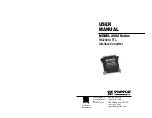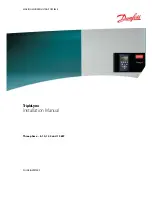
Page 27
©
2017 Sensata Technologies
Installation
2.6.2
Grounding on Boats
When installing the ME Series inverter/charger on a boat, there are several considerations that
must be followed when grounding to ensure a safe installation, prevent galvanic corrosion, and
adhere to American Boat and Yacht Council (ABYC) standards.
Ensure a Safe Ground Connection
When AC on the boat is being supplied by shorepower (also referred to as “utility power”), the
onboard neutral should be connected to safety ground on the dock. Consequently, neutral and safety
ground should not be connected anywhere on the boat when shorepower is present. When AC on
the boat is being supplied by the ME Series inverter, the inverter’s output neutral is connected to
safety ground through an internal relay using its neutral-to-ground connection (see Figure 2-14).
The DC ground terminal on the ME Series must also be connected to the boat’s safety ground bus.
This ensures that both the inverter’s AC and DC ground terminals are connected to the boat’s
safety ground bus as a safety measure to provide protection against faults, and to provide a path
for AC fault currents while the boat is connected to shorepower.
Preventing the Risk of Corrosion
The inverter’s AC and DC ground terminals must be connected to the boat’s safety ground to
provide an important safety feature. However, this ground connection introduces the risk of galvanic
corrosion and/or electrolysis of the boat’s underwater metallic hardware.
Two possible solutions are typically used to maintain the correct onboard grounding requirements
while greatly reducing (if not eliminating) the risk of galvanic corrosion. These solutions would be
either using a galvanic isolator, or an onboard isolation transformer.
Galvanic isolators allow high AC voltage faults to pass, but block low voltage corrosion/electrolysis
currents from conducting.
Marine isolation transformers enable the shorepower to be connected to one side of the transformer
while the boat’s AC wiring system is connected to the other side. Since transformers do not allow
DC currents to pass, the problem with galvanic corrosion is eliminated.
ABYC Inverter/Charger Grounding Requirements
1
• DC Grounding Connections:
1) The DC grounding conductor (equipment ground) shall be:
a) connected from the metallic case or chassis of the inverter/charger to the engine
negative terminal or its bus;
b) and, an ampacity equal to that of the DC positive conductor (under certain conditions,
this conductor may be one size smaller—refer the ABYC standard).
2) The inverter/charger’s negative battery terminal and DC grounded conductor (negative
cable) shall not be connected to the inverter case or chassis at the inverter/charger itself.
• AC Grounding Connections:
1) The AC grounding conductor (green) shall be connected to the inverter/charger in a manner
so that the AC ground connection will not be disconnected in servicing. This conductor is in
addition to and independent of the DC grounding conductor.
2) The neutral for AC power sources shall be grounded only at the following points:
a) The shorepower neutral is grounded only through the shorepower cable and not grounded
on board the boat.
b) The inverter neutral shall be grounded at the inverter and the output neutral shall be
disconnected from ground when the inverter is operating in charger/pass-through mode.
c) On systems using an isolation transformer or a polarization transformer, the inverter
neutral (and the transformer secondary neutral) may be grounded at the AC main grounding
bus instead of at the inverter.
Note
1
: See the ABYC standard for complete AC/DC grounding requirements.
















































